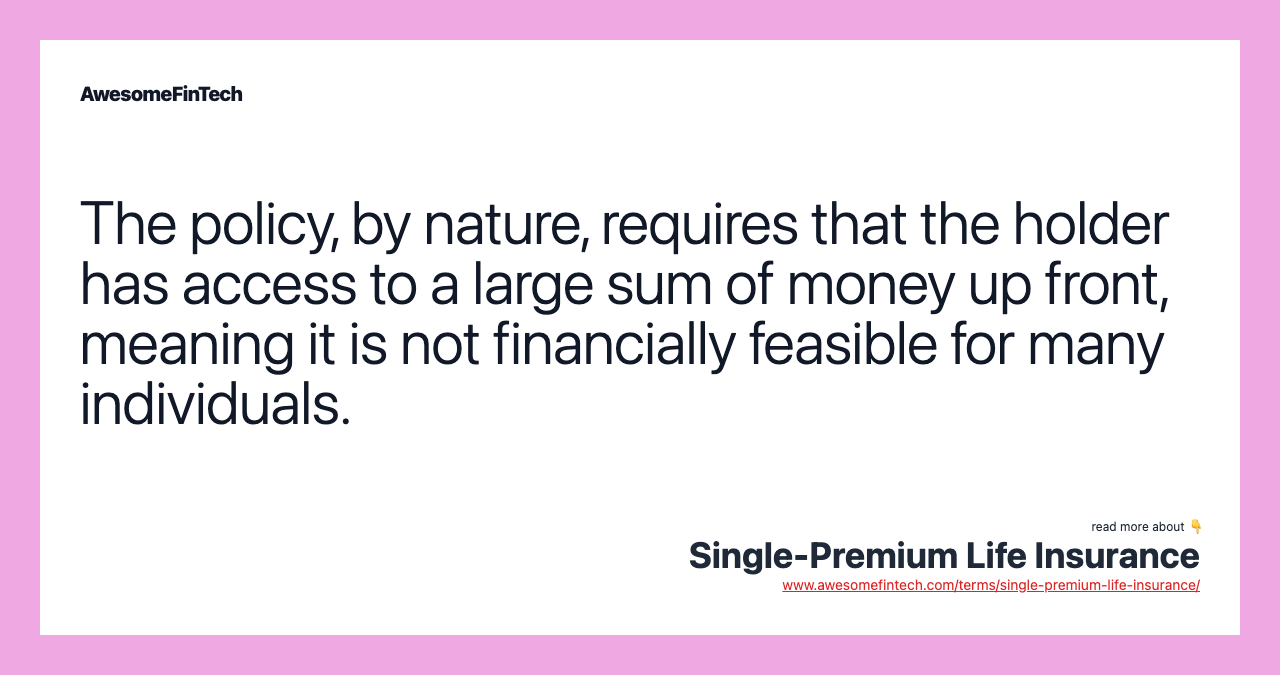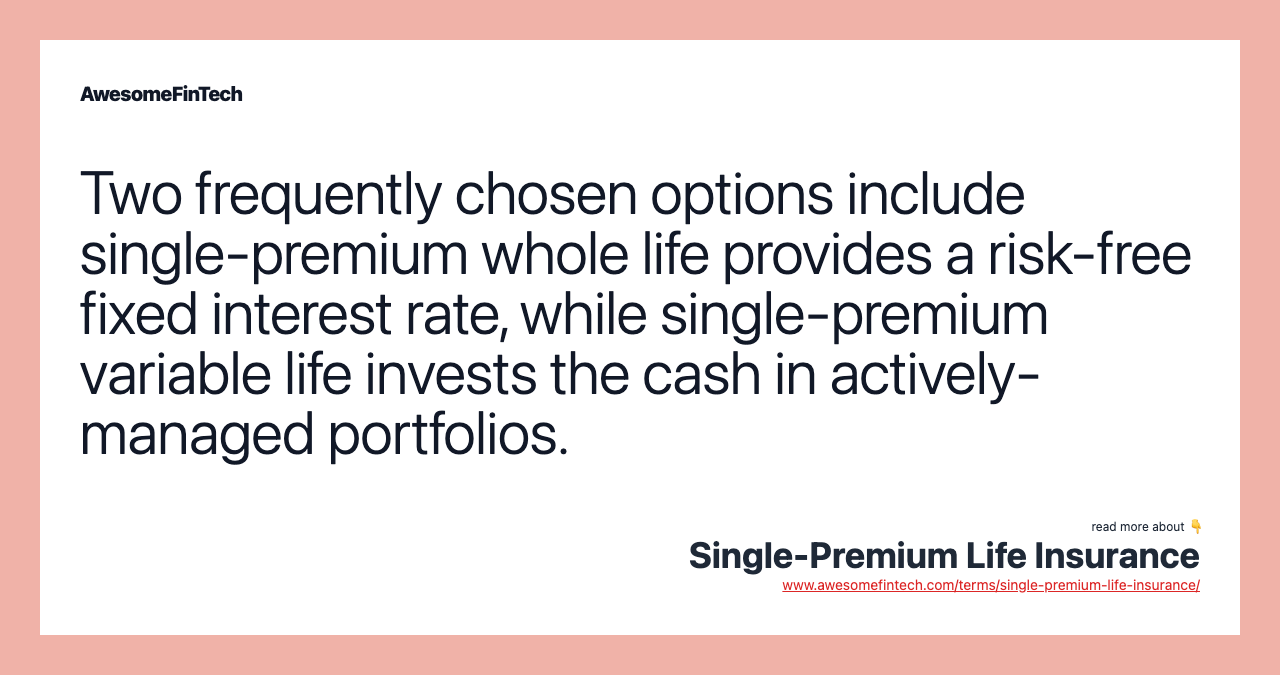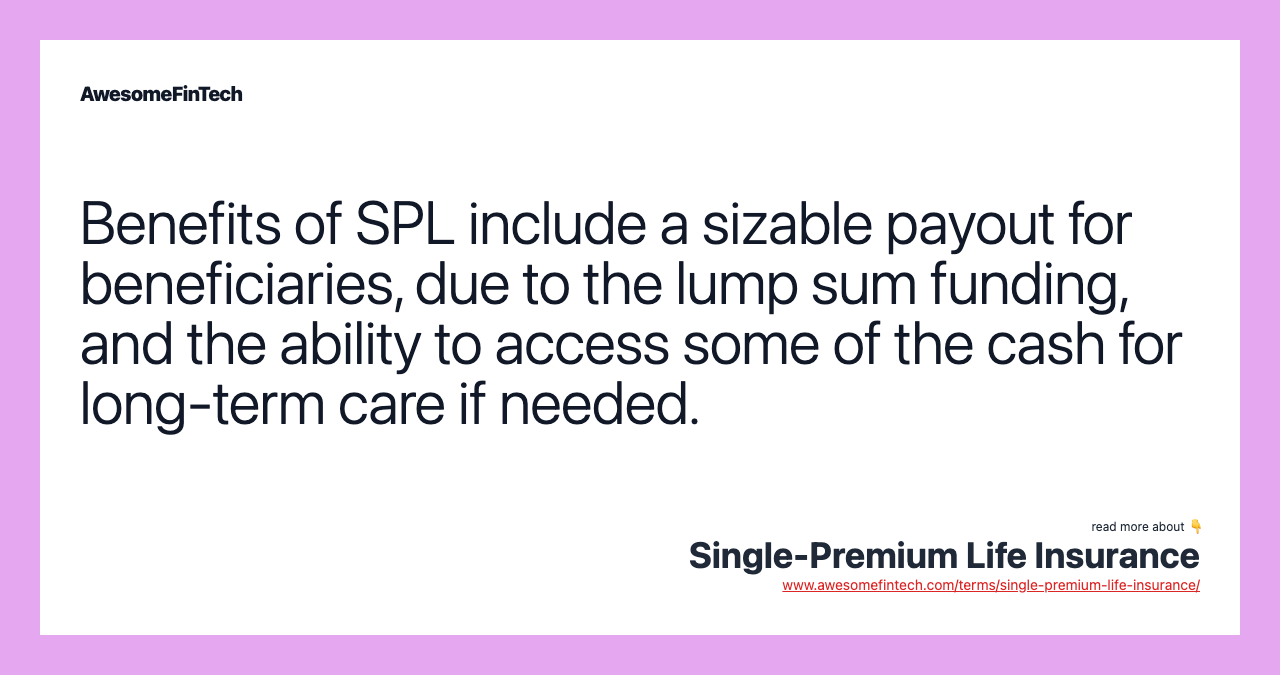Single-Premium Life Insurance
Single-premium life (SPL) insurance is a type of life insurance that charges the policyholder a single up-front premium payment to fully fund the policy. Two popular single-premium policies are single-premium whole life and single-premium variable life. Single-premium life (SPL) insurance is a type of life insurance that charges the policyholder a single up-front premium payment to fully fund the policy. Many life-insurance policies offer tax advantages, but single-premium life insurance policies were particularly advantageous. While all single-premium life insurance policies are MECs, whole life policies only become MECs if they exceed premium limits.

What Is Single-Premium Life Insurance?
Single-premium life (SPL) insurance is a type of life insurance that charges the policyholder a single up-front premium payment to fully fund the policy. It was once a popular tax shelter.
Single-premium life insurance is fully funded from the get go, so the cash builds up quickly; but the amount of the death benefit varies based on how much was invested and the age and the health of the policyholder at the time the insurance was accrued.




Understanding Single-Premium Life Insurance
Single-premium life insurance requires a large sum of money from the policyholder that puts this type of insurance out of reach of many applicants. The great advantage to single-premium life insurance is that the single payment fully funds the policy, immediately guaranteeing a sizable death benefit to the beneficiaries.
Another useful feature of some single-premium life insurance policies is their ability to finance long-term care, should the insured require it. Some single-premium life insurance policies allow policyholders to draw from the death benefit tax-free to pay living expenses. Such withdrawals decrease the amount of the death benefit accordingly.
Two popular single-premium policies are single-premium whole life and single-premium variable life. The two differ in how each policy accumulates a cash value. The first offers a risk-free fixed interest rate. The second invests the cash value in actively managed portfolios and comes with the risks and potential rewards of active investing.
Single-Premium Life Insurance as a Modified Endowment Contract
The U.S. Congress passed the Tax Reform Act of 1986 ostensibly to simplify the income-tax code and close loopholes. One loophole still open was single-premium life insurance, which quickly became popular as a tax shelter.
Many life-insurance policies offer tax advantages, but single-premium life insurance policies were particularly advantageous. First, the single premium payment allows the policyholder to dump a huge sum of cash into the policy at once. Second, many single-premium policies offered “wash loans” — loans against policies’ cash values that come effectively interest- and tax-free, the interest rate on the cash value canceling out the interest on the loans.
Congress passed the Technical and Miscellaneous Revenue Act of 1988 to discourage the use of life insurance policies as tax shelters. The act reclassified single-premium life insurance policies as modified endowment contracts (MECs). MECs grant loans and dispense withdrawal on a last-in-first-out (LIFO) basis. That means taxable gains come out of the policy before the tax-free return of principle, thus reducing their usefulness as tax shelters.
The introduction of the MEC prompted people to turn to whole life insurance policies for their tax benefits. While all single-premium life insurance policies are MECs, whole life policies only become MECs if they exceed premium limits. Investors looking to use whole life policies as tax shelters attempt to wring the maximum tax advantage of the policy without crossing into MEC territory.
As a single-premium life insurance plan is likely outside of most people's price range, the best life insurance companies offer several affordable alternatives.
Related terms:
Accelerated Option
An accelerated option in an insurance contract allows the policyholder to withdraw benefits earlier than they would normally be payable. read more
Benefits and Limitations of Active Investing
Active investing refers to an investment strategy that involves ongoing buying and selling activity by the investor. read more
Cash Value Accumulation Test (CVAT)
The cash value accumulation test (CVAT) is a test for determining whether a financial product can be taxed as an insurance contract instead of an investment. read more
Death Benefit
A death benefit is a payout to the beneficiary of a life insurance policy, annuity or pension when the insured or annuitant dies. read more
Life Insurance Guide to Policies and Companies
Life insurance is a contract in which an insurer, in exchange for a premium, guarantees payment to an insured’s beneficiaries when the insured dies. read more
Last In, First Out (LIFO)
Last in, first out (LIFO) is a method used to account for inventory that records the most recently produced items as sold first. read more
Long-Term Care (LTC) Insurance
Long-term care insurance coverage provides for the care of people over age 65 or with a chronic or disabling condition who need constant care. read more
Modified Endowment Contract (MEC)
A modified endowment contract (MEC) is the term given to a life insurance policy whose funding has exceeded federal tax law limits. read more
Rider
A rider is an insurance policy provision that adds benefits to or amends the coverage or terms of a basic insurance policy. read more
Tax Reform Act of 1986
The Tax Reform Act of 1986 is a law passed by Congress that reduced the maximum rate on ordinary income and raised the tax rate on long-term capital gains. read more